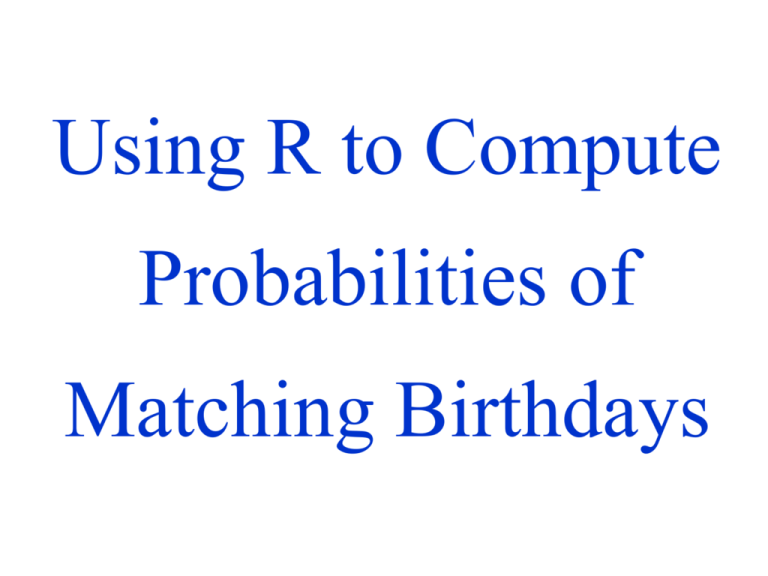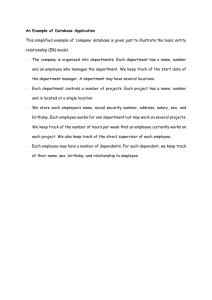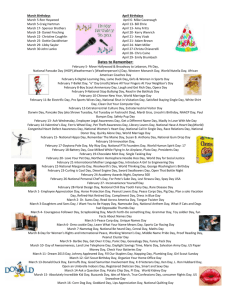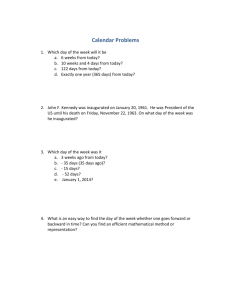Using R to Compute Probabilities of Matching Birthdays
advertisement

Using R to Compute
Probabilities of
Matching Birthdays
Bruce E. Trumbo*
Eric A. Suess
Clayton W. Schupp†
California State University, Hayward
JSM, August 2004
† Presenting at JSM
* btrumbo@csuhayward.edu
Statement of Birthday Problem
• 25 randomly chosen people in a room
• What is the probability two or more of them have
the same birthday?
• Model simplifications for a simple combinatorial
solution:
– Ignore leap years
– Assume all 365 days equally likely
• What error from assumptions?
Combinatorial Solution
• Let X = number of matches
• Seek P{X ≥ 1} = 1 – P{X = 0}
•
• Seek P{X ≥ 1} = 1 – 0.4313 = 0.5687
• In R: prod(1 - (0:24)/365)
Returns 0.4313003
For n People in the Room
• As n increases, clearly P{X ≥ 1} increases.
• If n = 366 (still ignoring leap years), we are
sure to get at least one duplication.
• But we will see P{X ≥ 1} becomes very
close to 1 for much smaller values of n.
• Easy to show using a loop in R.
R Script for Graph of P{Match}
p <- numeric(50)
for (n in 1:50) {
q <- 1 - (0:(n - 1))/365
p[n] <- 1 - prod(q)
plot(p)
# Makes Figure 1
p
# Makes prinout below
> p
[1] 0.000000000
...
[21] 0.443688335
[23] 0.507297234
[25] 0.568699704
...
[49] 0.965779609
0.002739726
0.475695308
0.538344258
0.598240820
0.970373580
}
Simulating the Birthday Process
• Use R to “survey” from m = 10000 rooms,
each with n = 25 randomly chosen people.
• Two convenient functions in R:
b <- sample(1:365, n, repl=T)
samples 25 objects from among
{1, 2, …, 365} with replacement,
length(unique(b))
counts the number of unique objects.
R Code Simulating the Birthday Process
n <- 25; m <- 10000; x <- numeric(m)
for (i in 1:m) {
b <- sample(1:365, n, repl=T)
x[i] <- n - length(unique(b)) }
mean(x); mean(x==0)
cut <- (0:(max(x) + 1)) - 0.5
hist(x, breaks=cut, freq=F, col=8)
> mean(x)
[1] 0.8081
> mean(x==0)
[1] 0.4338
Comments on Simulation Results
> mean(x)
[1] 0.8081
The proportion of rooms with no matches is very
close to P{X = 0} = 0.4313.
> mean(x==0)
[1] 0.4338
The average number of matches per room simulates
E(X), which is not easily obtained by combinatorial
methods.
How Serious Are Simplifying
Assumptions?
• We hope the 25 people in our room are
randomly chosen. (For example, not a
convention of twins, or Sagittarians.)
• We know there are February 29th birthdays
and that other birthdays are not uniformly
distributed. We hope this does not matter
much.
Empirical Daily Birth Proportions: By Month Jan '97 - Dec '99
(Percent of Uniform = 1/365 Per Day)
Percent
105
100
95
0
10
20
30
40
Month
Source: Nat'l Ctr. for Health Statistics
Simulation Easy to Generalize
Define a vector of weights:
w <- c(rep(4,200), rep(5,165), 1)
More extreme variation than actual.
Sample according to these weights:
sample(1:366, n, repl=T, prob=w)
Slight modification of the R code simulates
the nonuniform problem.
R Code Simulating the Birthday
Process With Weighted Probabilities
n <- 25; m <- 20000; x <- numeric(m)
w <- c(rep(4,200), rep(5,165), 1)
for (i in 1:m) {
b <- sample(1:366, n, repl=T, prob=w)
x[i] <- n - length(unique(b)) }
mean(x); mean(x==0)
Uniform Simulation
> mean(x)
[1] 0.819
[1] 0.8081
> mean(x==0)
[1] 0.42215
[1] 0.4338
Breakdown in Birthday Problem
• We have seen that mild departures from the
uniform do not change substantially.
• What about for extreme departures from the
uniform?
– Assume that half the birthdays are distributed
over a period of k weeks (k = 1, . . . , 26).
– Remainder are uniformly distributed over the
rest of the year.
Simulated Departures From Uniform
(Red Line Indicates Uniform Distribution)
Concluding Remarks
• Simulation allows us to assess assumptions.
Here the result was that realistic departures
from the uniform are relatively harmless.
• Simulating a case with a known answer builds
confidence in the simulation model to be used
for generalizing results.
• Using R, simulations are easy enough to use in
practical applications and in the classroom.
References
Peter Dalgaard: Introductory Statistics with R, 2002,
Springer.
William Feller: An Introduction to Probability
Theory and Its Applications, Vol. 1, 1950
(3rd ed., 1968), Wiley.
Thomas. S. Nunnikhoven: A birthday problem
solution for nonuniform frequencies,
The American Statistician, 46, 270–274, 1992.
Jim Pitman and Michael Camarri: Limit Distributions
and Random Trees Derived From the Birthday
Problem With Unequal Probabilities, Electron. J.
Probab. 5 Paper 2, 1-18, 2000
Web Resources
R software and manuals are available from
www.r-project.org
Birth frequencies are based on raw monthly totals are
available at
www.cdc.gov/nchs/products/pubd/vsus/
vsus.html
Auxiliary instructional materials for this article are
posted at
www.sci.csuhayward.edu/~btrumbo/bdmatch




![You`re invited to celebrate [child`s name]`s birthday at SCRAP! What](http://s3.studylib.net/store/data/007177272_1-c15601fb9e11b26854f13f1982e634e8-300x300.png)



